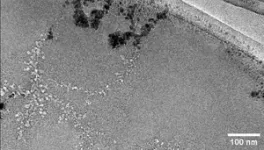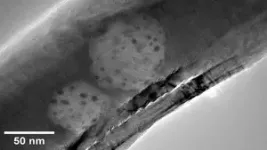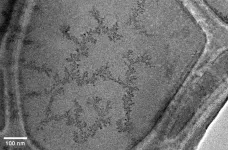The researchers will present their results at the spring meeting of the American Chemical Society (ACS). ACS Spring 2025 is being held March 23-27; it features about 12,000 presentations on a range of science topics.
“In the modern day, plastic is everywhere, including our devices that we carry around. And it’s a problem when we reach the end of that device’s life. It’s not biodegradable,” explains Bharat Baruah, a professor of chemistry at Kennesaw State University and the presenter of this research. “So, I asked, what if we can create something that’s natural and biodegradable instead?”
Baruah became interested in transparent woods thanks to his outside-of-work pursuits — namely, his woodworking hobby. But he realized that the transparent woods reported by other scientists used materials such as epoxies, a form of plastic, for strength. To find natural materials that would keep wood sturdy and stable over time, he again turned to his personal experiences.
Growing up in the state of Assam in northeastern India, Baruah encountered buildings that had been standing for centuries — long before the modern-day version of cement was invented. Instead, ancient masons created cement by mixing sand with sticky rice and egg whites. Baruah hypothesized that those same materials might be perfect for incorporating strength and stability into his transparent woods.
Wood has three components: cellulose, hemicellulose and lignin. To make it transparent, the lignin and hemicellulose are removed, leaving behind a porous, paper-like network of cellulose. Then, a colorless material fills in those pores, also restoring some rigidity.
Joined by Ridham Raval, an undergraduate student at the university, Baruah transformed pieces of balsa wood into natural, semi-transparent woods by pulling out the lignin and hemicellulose using a vacuum chamber and chemicals, including sodium sulfite (a delignifying agent), sodium hydroxide (a version of lye) and diluted bleach. Then, the pores were refilled by soaking them in an egg white and rice extract mixture, along with a curing agent called diethylenetriamine to keep the material see-through. The researchers say that these reagents, when used in small amounts, such as in this experiment, pose little threat to the environment.
In the end, the team was left with semi-transparent slices of wood that were durable and flexible.
The team next investigated some potential applications for their engineered woods, including as a replacement for glass windows. Again, Baruah tapped into his woodworker skills and renovated a birdhouse into a tiny, one-windowed, insulated home. To test the modernized abode’s energy efficiency, he put the birdhouse under a heat lamp and placed a temperature gauge inside. The temperature inside the house was between 9 to 11 degrees Fahrenheit (5 to 6 degrees Celsius) cooler when transparent wood was used than when glass was, suggesting that this new material could serve as an energy-efficient alternative to glass in windows.
To further expand the transparent wood’s potential applications, the team also incorporated silver nanowires into certain samples. This addition allowed the wood to conduct electricity, which could be useful for wearable sensors or coatings for solar cells. Silver nanowires aren’t biodegradable, but the team hopes to conduct further experiments using other conductive materials like graphene to maintain their fully natural transparent woods.
Though additional research is needed to boost the transparency of the woods, Baruah is happy that this initial step used natural and inexpensive materials. “I want to send a message to my undergraduate students that you can do interesting research without spending thousands of dollars,” he concludes.
The research was funded by Kennesaw State University and Purafil Inc., an air filtration manufacturer.
Visit the ACS Spring 2025 program to learn more about this presentation, “Fabrication of transparent wood from by impregnating voids in delignified wood and possible application in energy efficiency and electrical devices” and other science presentations.
###
The American Chemical Society (ACS) is a nonprofit organization founded in 1876 and chartered by the U.S. Congress. ACS is committed to improving all lives through the transforming power of chemistry. Its mission is to advance scientific knowledge, empower a global community and champion scientific integrity, and its vision is a world built on science. The Society is a global leader in promoting excellence in science education and providing access to chemistry-related information and research through its multiple research solutions, peer-reviewed journals, scientific conferences, e-books and weekly news periodical Chemical & Engineering News. ACS journals are among the most cited, most trusted and most read within the scientific literature; however, ACS itself does not conduct chemical research. As a leader in scientific information solutions, its CAS division partners with global innovators to accelerate breakthroughs by curating, connecting and analyzing the world’s scientific knowledge. ACS’ main offices are in Washington, D.C., and Columbus, Ohio.
Registered journalists can subscribe to the ACS journalist news portal on EurekAlert! to access embargoed and public science press releases. For media inquiries, contact newsroom@acs.org.
Note to journalists: Please report that this research was presented at a meeting of the American Chemical Society. ACS does not conduct research, but publishes and publicizes peer-reviewed scientific studies.
Follow us: Facebook | LinkedIn | Instagram
Title
Fabrication of transparent wood from by impregnating voids in delignified wood and possible application in energy efficiency and electrical devices
Abstract
This research aims to create transparent wood (TW) with multiple properties such as flexibility, optical transparency, and electrical conductivity. In modern society, electronic devices are an indispensable part of every arena of our lives. Sensors, energy storage devices, and flexible electronics1 require cheap, readily available materials and are easy to fabricate. Traditionally, plastics have been used in this category. However, it is harmful to the ecosystem and is not biodegradable. The research community and the industry are searching for an alternative that is cheaper, readily available, and easy to fabricate into electronic devices. Current research demonstrates the delignification of natural wood (NW) by chemical treatment. In our study, the delignified wood (DW) is impregnated with bio-compatible and bio-degradable polymer to create transparent wood (TW). By incorporating such natural polymers, we have also given way to flexibility in the TW. We further modified the TW to have electrical conductivity by incorporating silver nanowires (AgNWs). Such modified wood (MW) would have tremendous potential in optoelectronics, energy storage, and biomedical devices. We characterize samples with FTIR, Raman, UV-vis DRS, XRD, TGA, EDX, and SEM and further tests for energy efficiency.
END






